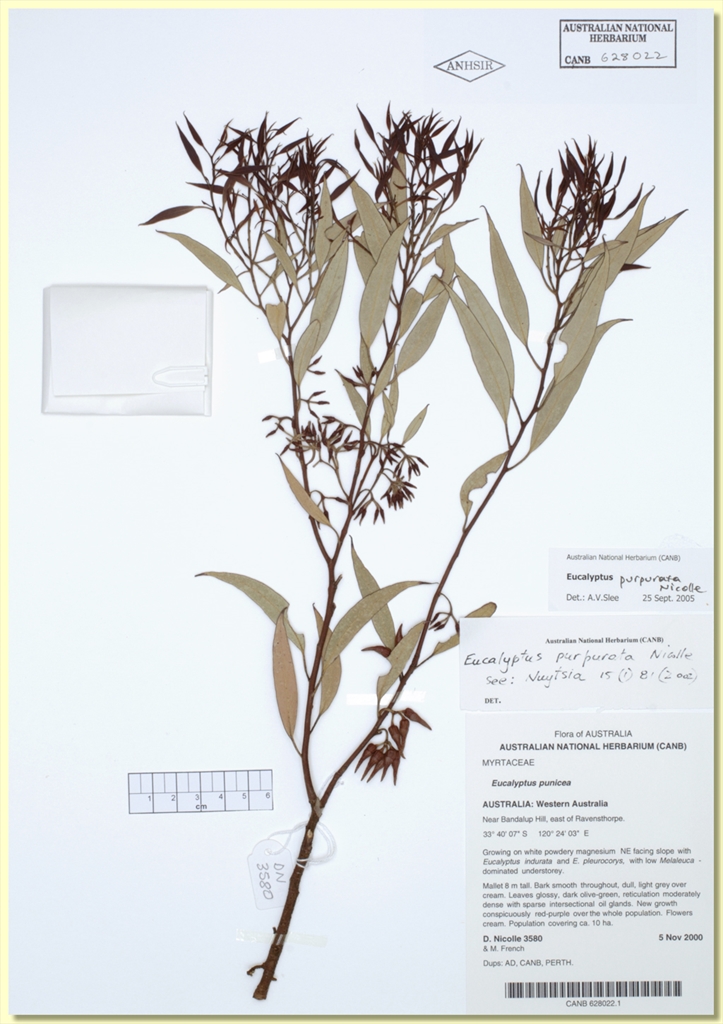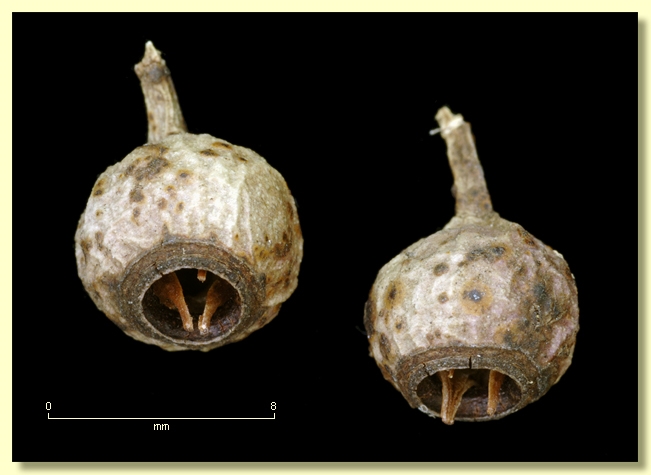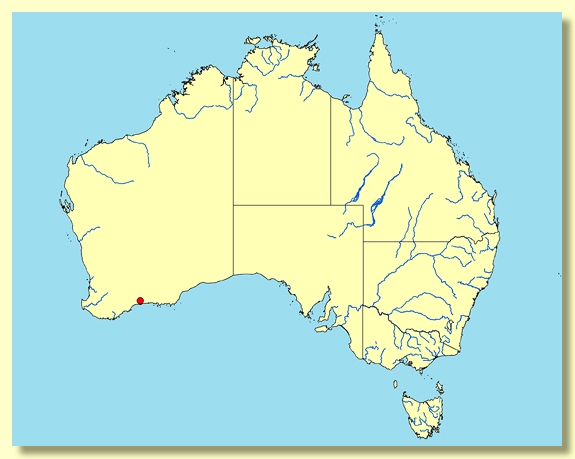Euclid - Online edition
Eucalyptus purpurata
Eucalyptus | Symphyomyrtus | Bisectae | Destitutae | Falcatae | Rugatae
Mallet to 10 m tall. Lignotuber absent.
Bark smooth throughout, mottled silvery grey to light grey over cream bark, shedding in strips.
Branchlets lack oil glands in the pith.
Juvenile growth (coppice or field seedlings to 50 cm): not seen.
Adult leaves alternate, petioles 0.7–1.7 cm long; blade lanceolate, 4.5–9.5 cm long, 0.6–1.6 cm wide, base tapering to petiole, margin entire, apex finely pointed, concolorous, glossy, dark green, side-veins acute, reticulation moderate, intramarginal vein close to margin, oil glands sparse, intersectional. New young leaf growth red-purple.
Inflorescence axillary unbranched, pendulous, peduncles 0.6–1.5 cm long, buds 7, 9 or 11 per umbel, pedicels 0.3–0.7 cm long. Mature buds ovoid with shallow ribs on hypanthium only, 1.1–1.5 cm long, 0.4–0.5 cm wide, scar present, operculum narrowly conical, not ribbed, stamens inflexed, anthers cuboid, versatile, dorsifixed, dehiscing by longitudinal slits, style long and straight, stigma blunt to ± tapered, locules 3(4), the placentae each with 4 vertical rows of ovules. Flowers creamy white.
Fruit on down-turned peduncles, pedicellate (pedicels 0.3–0.7 cm long), truncate-globose and somewhat flattened, 0.5–0.6 cm long, 0.6–0.7 cm wide, not ribbed, staminophore persistent and obscuring the vertically descending disc, valves 3(4), exserted and fragile.
Seeds brown to grey-brown, 1–2.5 mm long, ovoid or flattened-ovoid, dorsal surface smooth or very shallowly reticulate and sometimes with longitudinal furrows dorsally, hilum ventral.
Cultivated seedlings (measured at ca node 10): not grown (data from Nicolle, ibid.) cotyledons Y-shaped (bisected); leaves opposite, shortly petiolate, linear becoming disjunct, petiolate, elliptical, to 2.8 cm long, to 1 cm wide, blue-green, dull.
Flowering has been recorded in November.
A recently described mallet endemic to Western Australia, found only near Bandalup Hill, Ravensthorpe, where it occurs in more or less pure stands on white powdery soil containing magnesite. Eucalyptus purpurata has silvery grey and cream smooth bark, glossy green adult leaves and small pendulous ovoid buds with shallow ribbing on the lower part of the bud only, pendulous and smooth truncate-globose fruit 0.5–0.6 cm long, and petiolate juvenile leaves. The new growing tips and buds are reddish purple.
At its only known locality E. purpurata is unlikely to be confused with any other species. The only other smooth-barked, green-crowned mallet species in the area is the smooth-barked E. clivicola, which also has glossy dark green adult leaves but differs strongly in its elongated fusiform buds and cupular to cylindrical fruit held erect. Another local mallet species is E. cernua which has squat buds and fruit born on very broad strap-like peduncles.
Further to the north and north-west other similarly smooth-barked mallet species more closely related to E. purpurata occur: E. argyphea, found sporadically from Wickepin to Jerramungup and Lake King, has longer and wider buds with ribbing on base only rarely on the operculum, and larger, ribbed or smooth fruit; E. ornata, restricted to the area immediately around Kondininin, has larger buds coarsely, closely and sharply ribbed from base of the hypanthium to near the tip of the operculum and wide fruit with coarse ribs; E. recta, which is very restricted to the wheatbelt just east of Cadoux, has larger and completely smooth buds and fruit; and E. rugulata, found in the Hatter Hill to South Ironcap area east of Varley, and which has much larger buds, with pronounced but shallow ribbing on the hypanthium, and much larger shallowly ribbed fruit. The newly described mallet E. annettae differs profoundly in its glaucous branchlets, larger adult leaves short conical opercukum and ribbed buds and fruit, and is found only near Israelite Bay. Another related species, the mallee Eucalyptus ecostata, widespread in coastal and subcoastal areas around Ravensthorpe, differs in growth habit and never has new growth tinged with reddish purple, but has similarly unribbed buds and fruit.
This species was published after Brooker's (2000) classification of the eucalypts. E. purpurata belongs in Eucalyptus subgenus Symphyomyrtus section Bisectae subsection Destitutae because buds have two opercula, cotyledons are Y-shaped and branchlets lack oil glands in the pith. Within this sub-subsection E. purpurata belongs to a group of mallet and mallee species characterised by often pendulous inflorescences with pedicellate ovoid buds with a conical to beaked operculum, flattened-globose fruits with exserted fragile valves and adult leaves that are green, densely reticulate and have numerous intersectional oil glands and smooth bark. The species are the mallets E. falcata, E. ornata, E. purpurata, E. recta, E. rugulata and the recently described E. annettae; and the mallees E. dorrienii, E. petrensis, E. ecostata and the newly described E. opimiflora, plus the coastal and sub-coastal mallees E. goniantha (with two subspecies), E. kessellii (with two subspecies), E. notactites and E. semiglobosa. These mallets and mallees together form series Falcatae subseries Rugatae, albeit in a form somewhat modified from Brooker's classification.
Eucalyptus purpurata : Latin purpuratus , purple, referring to the purple-red new growth of leaves, branchlets and buds.













